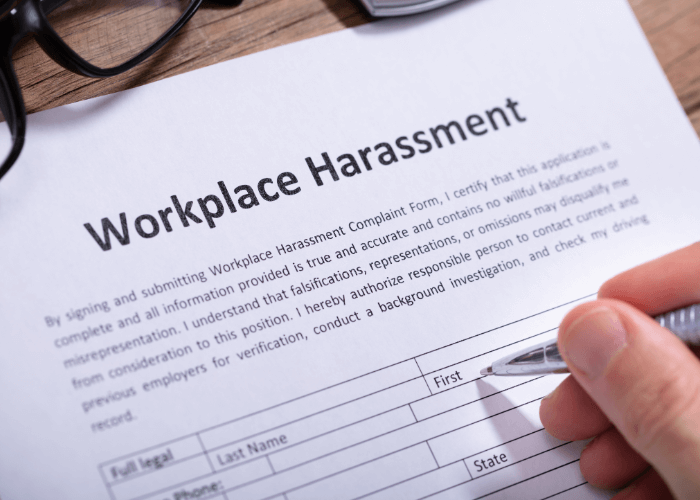What is Workplace Bullying, and How to Deal With It?
A standard 8-hour workday and a standard 40-hour workweek calculate about 160 hours a month and between 1600 and 2000 hours a year spent in your workplace. That’s about one-third of your adult life or nearly three full years of a 10-year period – if you never ever do overtime.
So, work is rarely just working, and it’s safe to say that the workplace environment is the second most vital provision for your well-being after your home.
In the light of all of the above, today we open the case of workplace bullying – a pervasive problem that affects millions of workers worldwide.
In the paragraphs below, we will discuss what workplace bullying is, the different types of bullying behavior, its effects on employees and organizations, its legal implications, and the strategies that employers can use to prevent and address it.
Introduction to Workplace Bullying: Definition and Statistics
Workplace bullying is a widespread concern that impacts millions of employees each year. It is defined as repeated and deliberate behavior intended to intimidate, humiliate, or harm an individual both personally and professionally.
Workplace bullying can take many forms and may involve physical, verbal, or psychological abuse. It can not only hinder one’s professional growth, but it can also impact the victim’s mental well-being and physical health.
Unfortunately, workplace bullying is more common than many people realize. A recent study by the Workplace Bullying Institute found that 30% of workers have experienced workplace bullying at some point in their careers. Furthermore, 52% of the bullied were non-management employees, and a skyrocketing 65% of bullies were the bosses themselves.
Considering the size and localization of the study, we might suggest that workplace bullying is an even more significant issue in developing countries and on a global scale.
Types of Workplace Bullying Behavior
According to the same study from the Workplace Bullying Institute, employers tend to rationalize and deny bullying. Sometimes, this can even happen among employees themselves.
Recognizing bullying behavior is the first step toward addressing and solving the issue. And though bullies can also be perfect gaslighters, it’s essential to identify inappropriate behavior and stand against it – no matter if you or your co-worker happen to be the victim.

So, what are the different types of bullying in the workplace?
- Humiliation and ridicule involve belittling or mocking an individual in front of others. This behavior can damage an individual’s self-esteem and create a hostile work environment.
- Micromanagement involves a supervisor or manager constantly monitoring and controlling an employee’s work. This can make employees feel like they are not trusted or valued, leading to decreased productivity and job satisfaction.
- Work interference occurs when a supervisor or manager disrupts an employee’s work by giving contradictory instructions, interrupting their work, or failing to provide necessary resources. This can make it difficult for employees to do their job effectively, thus leading to frustration and burnout.
- Retaliation emerges when an employee is punished or charged for reporting workplace bullying or other misconduct. This can create a culture of fear and discourage employees from reporting inappropriate behavior.
- Work overloads involve assigning an unreasonable amount of work or setting unrealistic expectations for an employee. The results often include signs of burnout, decreased productivity, and raised stress levels.
- Undermining work performance or reputation involves sabotaging an employee’s work or prestige as an expert. This behavior can damage an individual’s career and make it difficult for them to evolve in their specialization.
- Practical jokes or pranks are often considered witty or amusing by the bully. Except that they’re usually not. Workplace humiliation is nowadays not only practiced but broadcasted live on social media, thus deepening the self-esteem damage on the victim’s part.
- Institutional bullying is when an organization’s policies or procedures construct a hostile work atmosphere. This can include policies that discriminate against certain groups or fail to address workplace bullying.
- Discriminatory bullying involves bullying based on individual characteristics, such as race, gender, religion, or sexual orientation. That’s illegal and can lead to legal action in most countries around the world.
- Verbal abuse concerns using language intended to hurt, threaten, or humiliate an individual. It usually comes after one or more of the abovementioned behaviors and is also considered valid grounds for taking legal action against the bully.
- Sexual harassment involves unwanted sexual advances or comments from a supervisor or co-worker. This type of behavior is legally banned and requires immediate action.
All in all, workplace bullying can take many forms, but it always feels the same – inappropriate, wrong, and hurtful.

Effects of Workplace Bullying on The Employee and the Organization
The harmful effects of workplace bullying are inevitable for both the individual employee and the organization as a whole.
Psychological Effects On The Victim
The psychological effects of workplace bullying on victims can be severe and long-lasting. Ongoing harassment, humiliation, and intimidation can lead to anxiety, depression, and low self-esteem. The victim may also develop symptoms of post-traumatic stress disorder (PTSD) and have difficulty concentrating and completing tasks.
Anxiety attacks, characterized by sudden intense fear or discomfort, can also occur due to workplace bullying.
These psychological effects can significantly impact the victim’s personal and professional life, making it challenging to function in daily life and maintain healthy relationships.
Physical Effects On The Victim
The physical results of workplace bullying on victims are equally concerning. Sleep disturbances, such as insomnia and nightmares, are common among victims of workplace bullying, as the constant stress and anxiety make it difficult to relax even when out of the toxic environment.
Headaches, digestive problems, and high blood pressure are also expected physical symptoms of workplace bullying. In severe cases, victims may develop heart disease, a condition that is associated with long-term exposure to stress.
Effects On The Workplace Culture
Workplace bullying doesn’t just affect the victim; it also has a significant impact on the workplace culture as a whole.
Employees who witness or are aware of workplace bullying may experience decreased morale and a sense of unease, reducing their motivation to work. In addition, the high turnover rates associated with workplace bullying can also disrupt the organizational culture and decrease productivity.
Additionally, workplace bullying can lead to increased absenteeism and use of sick leave, further disrupting the workplace and increasing the cost of healthcare for the organization.
Effects On The Organization’s Productivity
When employees are bullied, their stimulus and job satisfaction decrease, thus lowering efficiency and productivity. Furthermore, employees who are teased and ridiculed may become distracted and disengaged from their work, leading to a well-measurable drop in the quality.
This, in turn, can negatively affect the organization’s reputation, leading to reduced customer satisfaction and fewer profits.
Bullying In The Workplace: Laws and Legal Implications
Employers are legally responsible for providing their employees with a safe and healthy work environment. Or else said – failure to address workplace bullying can result in legal consequences for the organization.
In some countries, there are laws that prohibit workplace bullying and harassment, and employers who do not comply with these laws could face legal action.
In addition, employers who fail to address workplace bullying may also face legal claims for compensation from employees who have been bullied. Such claims could be based on the grounds of negligence or breach of duty of care.

What Can Employers Do: Prevention and Intervention Strategies
Employers can take several measures to prevent and address workplace bullying, including:
- Establish a clear and comprehensive anti-bullying policy that outlines what constitutes bullying and the consequences of such behavior.
- Train employees and managers on the essence of workplace bullying and how to prevent it.
- Encourage employees to report bullying incidents and provide them with a confidential reporting system.
- Investigate all reported incidents of bullying in a timely and fair manner.
- Implement appropriate disciplinary actions against employees who engage in bullying behavior.
- Provide support and counseling to victims of bullying, be it within or out of the organization.
- Foster a positive work culture that values respect, teamwork, and open communication.
- Monitor the workplace for signs of bullying and take proactive measures to prevent it.
These measures are more standard than exotic in developed countries. Still, there’s a lot to be done in many parts of the world where bullying is still not taken seriously enough and is still not penalized accordingly.
Conclusion
Workplace bullying is a serious problem that can have severe psychological, physical, and financial consequences for both employees and organizations.
To avoid culturing such behaviors, employers can develop a positive work culture that promotes respect, collaboration, and productivity by taking proactive measures to prevent and address conflicts in or between their teams.
To do so, it is crucial for organizations to recognize the adverse effects of workplace toxicity and accept their role as not merely a place to work but also a place to live – and live well.

